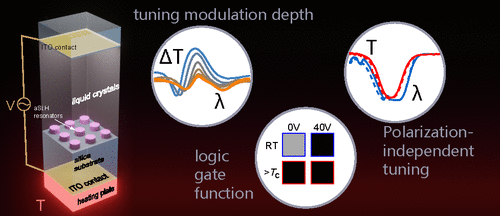当前位置:
X-MOL 学术
›
ACS Photonics
›
论文详情
Our official English website, www.x-mol.net, welcomes your feedback! (Note: you will need to create a separate account there.)
Multiresponsive Dielectric Metasurfaces
ACS Photonics ( IF 7 ) Pub Date : 2021-06-01 , DOI: 10.1021/acsphotonics.1c00371 Chengjun Zou 1, 2 , Cristina Amaya 1 , Stefan Fasold 1 , Alexander A. Muravsky 3 , Anatoli A. Murauski 3 , Thomas Pertsch 1, 4 , Isabelle Staude 1, 2
ACS Photonics ( IF 7 ) Pub Date : 2021-06-01 , DOI: 10.1021/acsphotonics.1c00371 Chengjun Zou 1, 2 , Cristina Amaya 1 , Stefan Fasold 1 , Alexander A. Muravsky 3 , Anatoli A. Murauski 3 , Thomas Pertsch 1, 4 , Isabelle Staude 1, 2
Affiliation

|
Tunable optical metasurfaces demonstrate a number of remarkable properties that are promising for realizing photonic devices for potential applications in telecommunications, holographic displays, and spatial light modulators, to name just a few. Integrating nematic liquid crystals (LCs) with dielectric metasurfaces has been established as an efficient tuning approach, which provides a large modulation of the metasurface optical response while being compatible with optoelectronic platforms and established LC-on-silicon technologies. Up to date tuning of LC-integrated metasurfaces using either temperature or applied voltage as separate external stimuli has been demonstrated. Here we introduce the concept of multiresponsive metasurfaces and suggest that the simultaneous application of two or more stimuli can expand the functionality of metasurface-based devices. To illustrate this concept, we present an experimental study where we combine electrical and thermal tunability of LC-integrated dielectric metasurfaces. By simultaneously applying both stimuli, we show that several new functionalities, such as tuning the modulation depths, nearly polarization-independent tuning, and gated response can be realized, all of which cannot be achieved with just a single stimulus. Our results establish multiresponsive metasurfaces as a new research direction in nanophotonics, and can be used for the design of novel metasurface-based photonic systems offering versatile dynamic control of the properties of light fields.
中文翻译:

多响应介电超表面
可调谐光学超表面展示了许多显着的特性,这些特性有望实现光子器件在电信、全息显示器和空间光调制器等领域的潜在应用,仅举几例。将向列液晶 (LC) 与介电超表面集成已被确立为一种有效的调谐方法,它提供超表面光学响应的大调制,同时与光电平台和已建立的硅基 LC 技术兼容。迄今为止,使用温度或施加的电压作为单独的外部刺激对 LC 集成超表面进行了调整。在这里,我们介绍了多响应超表面的概念,并建议同时应用两个或多个刺激可以扩展基于超表面的设备的功能。为了说明这个概念,我们提出了一项实验研究,其中我们结合了 LC 集成介电超表面的电和热可调性。通过同时应用这两种刺激,我们表明可以实现几个新功能,例如调整调制深度、几乎与极化无关的调谐和门控响应,所有这些都无法仅通过单个刺激来实现。我们的研究结果确立了多响应超表面作为纳米光子学的一个新研究方向,可用于设计基于超表面的新型光子系统,提供对光场特性的通用动态控制。为了说明这个概念,我们提出了一项实验研究,其中我们结合了 LC 集成介电超表面的电和热可调性。通过同时应用这两种刺激,我们表明可以实现几个新功能,例如调整调制深度、几乎与极化无关的调谐和门控响应,所有这些都无法仅通过单个刺激来实现。我们的研究结果确立了多响应超表面作为纳米光子学的一个新研究方向,可用于设计基于超表面的新型光子系统,提供对光场特性的通用动态控制。为了说明这个概念,我们提出了一项实验研究,其中我们结合了 LC 集成介电超表面的电和热可调性。通过同时应用这两种刺激,我们表明可以实现几个新功能,例如调整调制深度、几乎与极化无关的调谐和门控响应,所有这些都无法仅通过单个刺激来实现。我们的研究结果确立了多响应超表面作为纳米光子学的一个新研究方向,可用于设计基于超表面的新型光子系统,提供对光场特性的通用动态控制。我们表明可以实现几个新功能,例如调节调制深度、几乎与极化无关的调谐和门控响应,所有这些功能都无法仅通过单个刺激来实现。我们的研究结果确立了多响应超表面作为纳米光子学的一个新研究方向,可用于设计基于超表面的新型光子系统,提供对光场特性的通用动态控制。我们表明可以实现几个新功能,例如调节调制深度、几乎与极化无关的调谐和门控响应,所有这些功能都无法仅通过单个刺激来实现。我们的研究结果确立了多响应超表面作为纳米光子学的一个新研究方向,可用于设计基于超表面的新型光子系统,提供对光场特性的通用动态控制。
更新日期:2021-06-17
中文翻译:

多响应介电超表面
可调谐光学超表面展示了许多显着的特性,这些特性有望实现光子器件在电信、全息显示器和空间光调制器等领域的潜在应用,仅举几例。将向列液晶 (LC) 与介电超表面集成已被确立为一种有效的调谐方法,它提供超表面光学响应的大调制,同时与光电平台和已建立的硅基 LC 技术兼容。迄今为止,使用温度或施加的电压作为单独的外部刺激对 LC 集成超表面进行了调整。在这里,我们介绍了多响应超表面的概念,并建议同时应用两个或多个刺激可以扩展基于超表面的设备的功能。为了说明这个概念,我们提出了一项实验研究,其中我们结合了 LC 集成介电超表面的电和热可调性。通过同时应用这两种刺激,我们表明可以实现几个新功能,例如调整调制深度、几乎与极化无关的调谐和门控响应,所有这些都无法仅通过单个刺激来实现。我们的研究结果确立了多响应超表面作为纳米光子学的一个新研究方向,可用于设计基于超表面的新型光子系统,提供对光场特性的通用动态控制。为了说明这个概念,我们提出了一项实验研究,其中我们结合了 LC 集成介电超表面的电和热可调性。通过同时应用这两种刺激,我们表明可以实现几个新功能,例如调整调制深度、几乎与极化无关的调谐和门控响应,所有这些都无法仅通过单个刺激来实现。我们的研究结果确立了多响应超表面作为纳米光子学的一个新研究方向,可用于设计基于超表面的新型光子系统,提供对光场特性的通用动态控制。为了说明这个概念,我们提出了一项实验研究,其中我们结合了 LC 集成介电超表面的电和热可调性。通过同时应用这两种刺激,我们表明可以实现几个新功能,例如调整调制深度、几乎与极化无关的调谐和门控响应,所有这些都无法仅通过单个刺激来实现。我们的研究结果确立了多响应超表面作为纳米光子学的一个新研究方向,可用于设计基于超表面的新型光子系统,提供对光场特性的通用动态控制。我们表明可以实现几个新功能,例如调节调制深度、几乎与极化无关的调谐和门控响应,所有这些功能都无法仅通过单个刺激来实现。我们的研究结果确立了多响应超表面作为纳米光子学的一个新研究方向,可用于设计基于超表面的新型光子系统,提供对光场特性的通用动态控制。我们表明可以实现几个新功能,例如调节调制深度、几乎与极化无关的调谐和门控响应,所有这些功能都无法仅通过单个刺激来实现。我们的研究结果确立了多响应超表面作为纳米光子学的一个新研究方向,可用于设计基于超表面的新型光子系统,提供对光场特性的通用动态控制。


























 京公网安备 11010802027423号
京公网安备 11010802027423号